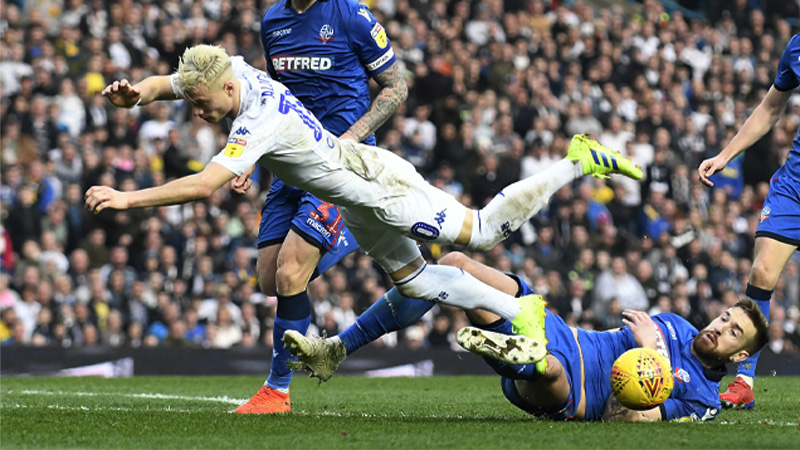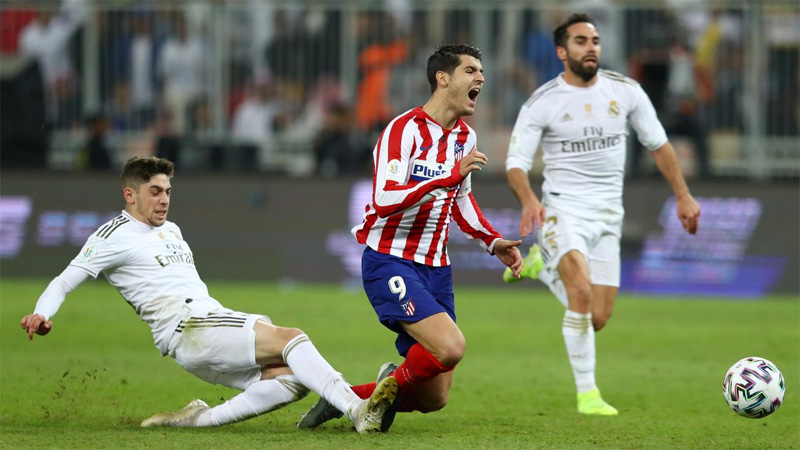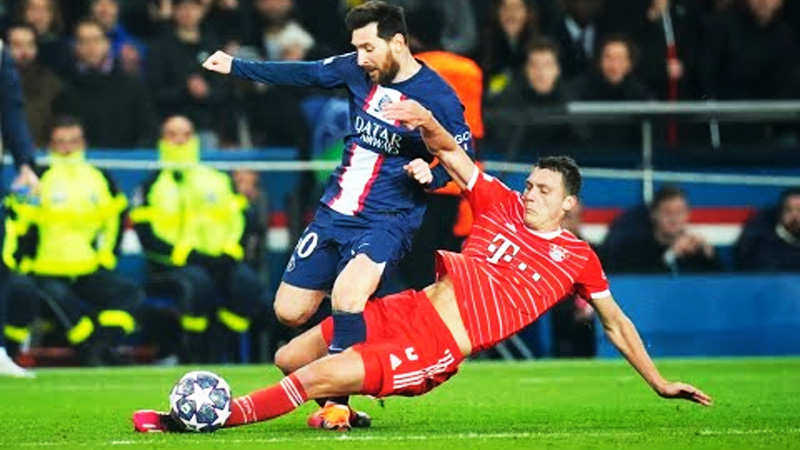Before you get into the field, you must learn about the rules regarding fouls in soccer. One common soccer foul that many players often get confused about is the soccer tackling from behind foul. It occurs when a player slides into an opponent from behind in an attempt to win the ball.
This type of tackle is often considered to be dangerous, as it can easily result in injury. In most cases, a tackling from behind foul will result in a direct free kick for the fouled player. In more serious cases, the offending player may be shown a yellow or red card.
Although there are some exceptions, in general, it’s best to avoid tackling from behind. This type of tackle is simply not worth the risk of injury. Let’s get into the details and find out more about tackling from behind fouls and related rules.
Understanding Soccer Tackling from Behind Foul
In soccer, tackling from behind refers to a situation where a player attempts to tackle an opponent from behind, usually from their blind side or from a position where they cannot see the tackler approaching.
This type of tackle is considered dangerous and can result in serious injury to the player being tackled. As a result, tackling from behind is generally considered a foul in soccer.
The Laws of the Game, which govern the rules of soccer, state that a player must not tackle an opponent from behind in a careless, reckless, or excessive manner.
If a player commits a tackle from behind that is deemed to be careless, reckless, or excessive, the referee may award a free kick or even issue a yellow or red card, depending on the severity of the foul.
The primary concern with tackling from behind is the potential for causing injury, as the player being tackled may not be prepared for the challenge and could be caught off guard.
It is important for players to prioritize the safety of their opponents and avoid tackles from behind whenever possible.
Rules Regarding Tackling from Behind in Soccer

Source: mitre
In soccer, tackling from behind is generally considered a foul and can result in disciplinary action. Here are some rules and guidelines regarding tackling from behind:
Careless, Reckless, or Excessive Force
The Laws of the Game state that a player must not tackle an opponent in a careless, reckless, or excessive manner. Tackling from behind is often seen as a reckless act, as it can endanger the safety of the opponent.
Direct Free Kick
If a player tackles an opponent from behind in a manner that is deemed careless, reckless, or excessive, the opposing team is awarded a direct free kick. This means that the team can take a free kick directly at the goal without any intervening players.
Yellow or Red Card
Depending on the severity of the tackle from behind, the referee may also issue a yellow or red card to the offending player. A yellow card is a caution, while a red card results in the player being sent off the field and the team playing with one less player.
Advantage Rule
In some cases, if the referee determines that the team being tackled from behind has a clear advantage, they may choose to play the advantage and not award a free kick. This is done to allow the attacking team to continue their play without interruption.
VAR Review
In certain competitions or leagues where Video Assistant Referee (VAR) technology is available, the referee may consult the VAR to review the tackle from behind and make a more informed decision regarding the foul and any disciplinary action.
It’s important to note that the interpretation of tackling from behind can vary slightly depending on the referee’s judgment and the specific circumstances of the tackle. However, the general principle is to discourage tackles from behind to ensure the safety of the players.
What Is the Punishment for Tackling from Behind?

Source: foxsports
The punishment for tackling from behind in soccer can vary depending on the severity of the foul and the discretion of the referee. Here are some possible punishments:
Free Kick
If a player tackles an opponent from behind in a manner that is deemed careless, reckless, or excessive, the opposing team is awarded a free kick. The free kick is typically taken from the spot where the foul occurred.
Yellow Card
In cases where the tackle from behind is considered reckless or shows a lack of regard for the safety of the opponent, the referee may issue a yellow card to the offending player. A yellow card serves as a caution and is a formal warning.
Red Card
If the tackle from behind is deemed to be particularly dangerous, violent, or malicious, the referee may issue a red card to the player. A red card results in the player being sent off the field and the team playing with one less player for the remainder of the match.
Penalties and Suspensions
In addition to the immediate punishment of a yellow or red card, more severe tackles from behind can lead to further penalties and suspensions.
The governing body of the competition or league may review the incident and impose additional fines, suspensions, or other disciplinary measures on the player involved.
It’s important to note that the severity of the punishment can depend on various factors, such as the intent, force, and potential for injury in the tackle.
Referees have some discretion in interpreting the severity of the foul and determining the appropriate punishment based on the Laws of the Game.
Why Are Tackling from Behind Rules Considered Controversial?
Tackling from behind in soccer can be controversial due to several reasons:
Subjectivity
The interpretation of tackling from behind can be subjective, as it often depends on the referee’s judgment and perception of the situation. Different referees may have different thresholds for what constitutes a foul from behind, leading to inconsistencies in how the rule is applied.
Player Safety
Tackling from behind is considered dangerous and can pose a significant risk of injury to the player being tackled. This has led to concerns about player safety and calls for stricter enforcement of rules against tackling from behind.
Intent and Fairness
Determining the intent of a player when tackling from behind can be challenging. Some tackles from behind may be accidental or a result of mistimed challenges, while others may be deliberate attempts to harm or disrupt the opponent.
This ambiguity can lead to debates about whether the punishment is fair and proportionate to the offense.
Game Flow and Advantage
In some situations, a tackle from behind may be committed to prevent an opponent from gaining an advantage or scoring a goal.
This can create debates about whether the referee should play the advantage or stop play to penalize the foul. Balancing the need to maintain the flow of the game with ensuring fair play can be a contentious issue.
VAR Controversies
The introduction of Video Assistant Referee (VAR) technology has added another layer of controversy to tackling from behind. VAR decisions can be scrutinized and debated, leading to disagreements about the accuracy and consistency of the review process.
Overall, the controversy surrounding tackling from behind in soccer stems from the subjective nature of the rule, concerns about player safety, and the potential impact on the fairness and flow of the game.
FAQs
Why is tackling from behind considered a foul?
Tackling from behind is considered a foul because it is a dangerous play that can lead to serious injuries, such as ankle or knee injuries, due to the lack of visibility and protection for the tackled player.
Are there any exceptions to tackling from behind fouls?
In certain situations, such as when a player is making a legitimate attempt to play the ball and accidentally makes contact from behind, the referee may not penalize it as a foul. However, this is subjective and depends on the referee’s judgment.
Are tackling from behind fouls more common in professional soccer?
Tackling from behind fouls can occur at any level of soccer, but they are generally less common in professional soccer due to stricter enforcement of rules and increased player discipline.
Are there any specific rules regarding tackling from behind fouls?
The Laws of the Game state that any tackle from behind that endangers the safety of an opponent can result in a foul. Referees have the discretion to interpret and penalize tackling from behind fouls accordingly.
How can players avoid committing tackling from behind fouls?
Players can avoid committing tackling from behind fouls by focusing on proper positioning, timing, and technique when attempting to win the ball. It is important to prioritize player safety and avoid reckless challenges from behind.
Parting Words
As the debate surrounding soccer tackling from behind foul continues, it is clear that finding a middle ground is crucial. Soccer’s governing bodies, coaches, players, and fans must work together to address the concerns surrounding player safety while preserving the essence of the game.
Stricter enforcement of existing rules, improved player education on safe tackling techniques, and the implementation of new technologies to aid referees in making accurate decisions are all potential avenues for progress.
Additionally, fostering a culture of respect and fair play among players can contribute to reducing the occurrence of dangerous tackles.
Ultimately, the goal is to create an environment where players can showcase their skills and athleticism without compromising their well-being.
By striking a balance between aggression and player safety, soccer can continue to captivate audiences worldwide while ensuring the long-term health and longevity of its participants.







